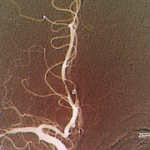Researchers enrolled 36 patients with Takayasu’s who relapsed while on corticosteroid treatment and who were then given at least twice their corticosteroid dose at relapse in order to bring them into remission. Relapse was defined as meeting at least two of these criteria: objective systemic symptoms, such as fever or weight loss; subjective systemic symptoms, such as malaise or headache; elevated inflammation markers; vascular lesions including bruises or loss of pulse; or ischemic symptoms accompanied by organ lesions. Imaging was not required when assessing patients for these relapse criteria.
After reaching remission, patients were randomized to receive either 162 mg per week of the anti–interleukin 6 agent, tocilizumab (TCZ), subcutaneously or placebo. The corticosteroids were tapered.
After 48 weeks, there was a trend (P=0.0596) toward relapse suppression for the TCZ group, but the primary endpoint of time to first relapse was not meant because it wasn’t statistically significant, said Yoshikazu Nakaoka, MD, PhD, of the National Cerebral and Cardiovascular Center Research Institute in Osaka, Japan.
The amount of time that passed before patients showed at least two of the five criteria for relapse—the “time to signs of relapse”—were all individually longer in the TCZ group, Dr. Nakaoka said.
There was a similar number of adverse events in each group.
“Although the primary endpoint was not met, a trend favored tocilizumab over placebo for time to relapse of Takayasu’s without new safety concerns,” Dr. Nakaoka said.
‘We need to better identify the patients that really need tocilizumab for GCA & optimal duration of this therapy in the course of disease.’ —Dr. Samson
Tocilizumab in GCA
On the topic of TCZ therapies, session speakers discussed an open-label study of 20 French patients newly diagnosed with giant cell arteritis (GCA) who were given four intravenous infusions of TCZ (at 8 mg/kg each) as an add-on therapy to glucocorticoids in their first three months of treatment for the disease.3 Researchers found that 75% of the patients met the primary endpoint of no relapse at 26 weeks while taking no more than 0.1 mg/kg per day of prednisone.
Researchers also found that relapse can occur after TCZ is stopped, especially in patients with aortitis, said Maxime Samson, MD, PhD, assistant professor of immunology at University Hospital in Dijon, France. He acknowledged that having no control group was a limitation. But the results, the researchers said, were nonetheless encouraging for the potential use of TCZ in this setting.
Adalimumab was studied as a steroid-sparing agent in GCA in the recent HECTHOR study, with the same endpoint and similar patient population, but with a control arm on prednisone and placebo.4 In that study, the prednisone-only arm reached the primary endpoint only 50% of the time, an indication that TCZ as an add-on might be superior to staying on prednisone only, Dr. Samson said.


